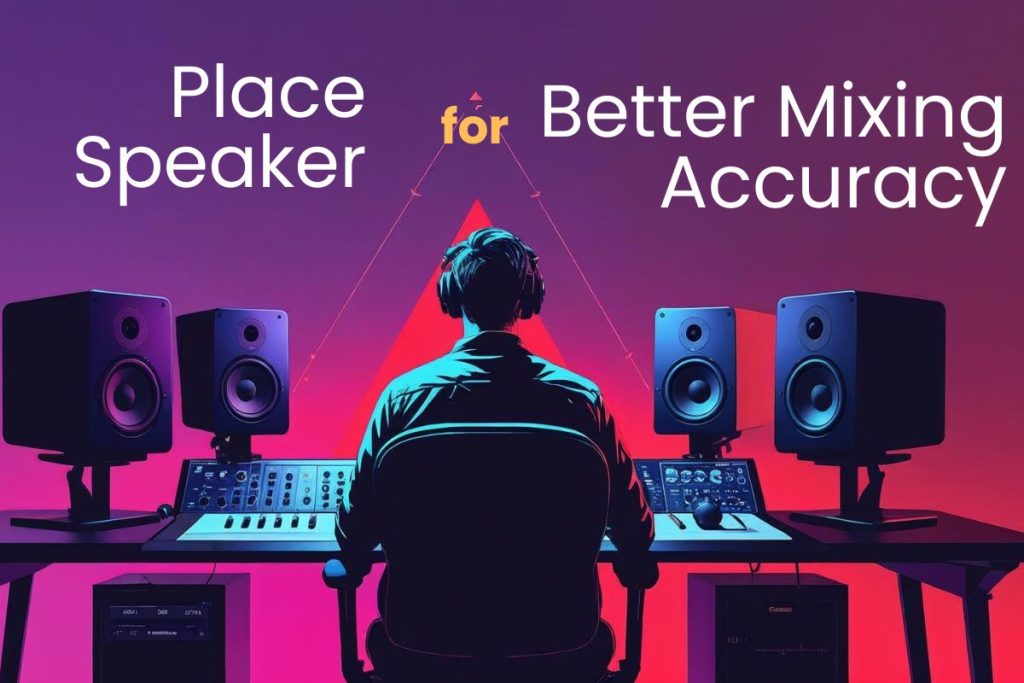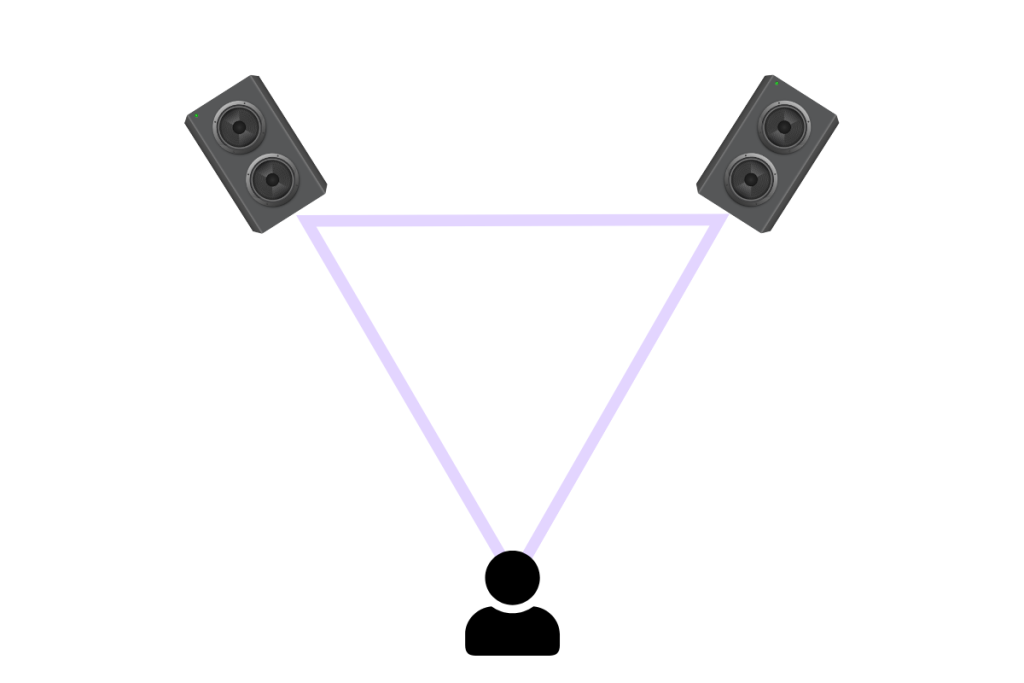You can spend hours tweaking EQ or buying new plugins, but if your speakers are in the wrong place, your mixes will never sound the way you expect. It happens that you’ve worked all night on a track that sounds perfect in your room. Then you played it in your car the next day and realize the bass is booming or the vocals are buried. That disconnect often comes down to speaker placement, not your mixing skills.

The good news is that you don’t need expensive acoustic panels. Even a perfectly treated studio won’t be much helpful here also. Just positioning your speakers correctly can transform how clearly you hear your music. So simple.
Table of Contents
Wondering Why Speaker Placement Is So Important?
Watch Out for Desk Reflections
Common Mistakes to Avoid for Accurate Mixing
Wondering Why Speaker Placement Is So Important?
Think of speakers as light bulbs. They don’t just shine straight ahead; the sound spreads out and bounces around the room. If your monitors sit against a wall, those reflections boost the bass, making you think your low end is bigger than it really is. If they’re aimed too wide, the stereo image feels off. It’s the same as watching a movie where the dialogue comes from the sides of the screen instead of the center.
Let us make it easier to understand. Say you mix a hip-hop track at home and your speakers are tucked into the corners of your desk. As a result of the position, you hear a huge bass while mixing, so you cut a lot of it out. When you play that same mix on a Bluetooth speaker, it suddenly sounds thin and weak. Don’t blame any other settings. It’s your room that lied to you.
Accurate placement ensures your speakers tell the truth. What you hear is close to what others will hear on earbuds, cars, or big speakers outside your room. That’s what,
Mixing accuracy means your mix translates everywhere.
Start with the Triangle Rule

One of the simplest, most reliable setups is the equilateral triangle method. Picture it like this:
- Your head is one corner of the triangle.
- Each speaker is another corner.
- All three sides are the same length.
So, if your speakers are three feet apart, your chair should also be three feet back. Because it locks you into the “sweet spot”. Sweet spot is the listening position where the stereo field is balanced. You can hear left, right, and center without one side overpowering the other.
Here’s a real-world test: put on a song with clear stereo panning, like The Beatles’ Come Together or a modern EDM track where synths bounce left to right. If your triangle is set up properly, those pans will feel natural and centered. If it isn’t, you’ll notice one side sounds louder, or the middle feels hollow.
Keep Tweeters at Ear Height
Studio monitors have two main parts: the woofer for low sounds and the tweeter for high sounds. The tweeter needs to sit at the same height as your ears when you’re in your mixing position. This ensures you hear the full detail of vocals, cymbals, and high instruments. If tweeters are too high or low, the sound will miss your ears and you’ll lose clarity.
Use stands, foam pads, or even sturdy books to raise them. The goal is simple: when you sit down, the tweeters should point straight at your ears.
Angle Your Speakers Correctly
Speakers should face you; NOT sit flat against the wall. Angle them inward slightly so both aim directly at your head. The standard setup is about 60 degrees between the two monitors. This angling sharpens the stereo image. Without it, instruments may sound wider or misplaced. With proper angling, panned sounds stay balanced, and you can hear left, right, and center clearly.
Give Them Some Breathing Room
Placing speakers against a wall or in a corner boosts bass unnaturally. This tricks you into lowering bass in your mix, which then sounds weak on other systems. Pull your monitors about 2–3 feet away from the wall and avoid corners. If the space is tight, use foam, bass traps, or heavy curtains behind them. Even small distance changes can make your mix more accurate.
Watch Out for Desk Reflections
When monitors sit directly on a desk, sound bounces off the surface before reaching your ears. This creates phase problems and harsh mids, making your mix sound muddy or boxy. To fix this, place your speakers on stands so they sit slightly above the desk. If that’s not possible, use isolation pads to absorb desk vibrations. Both methods keep the sound clean and focused.
Match Your Room Size
Small rooms exaggerate bass, while large rooms cause echoes and reverb. Each space shapes how your monitors sound, so placement must match the room. In smaller rooms, pull speakers away from walls and corners to reduce bass buildup. In bigger rooms, add rugs, curtains, or bookshelves to reduce reflections and echoes. This makes your mixes more balanced.
Test with Reference Tracks
After setup, test with songs you know well. Reference tracks show if your monitors are telling the truth or if the room is coloring the sound. If the music sounds too boomy, pull the speakers forward. If vocals lean left or right, adjust the angle. Use a mix of genres you trust to confirm your placement is accurate.
Common Mistakes to Avoid for Accurate Mixing
Even with the best monitors, a wrong speaker placement can ruin how you hear your mix. Small mistakes add up, and suddenly your track sounds good in your room but completely different in the car or on headphones. Knowing what not to do is just as important as knowing the correct setup.
1. Placing Speakers Against a Wall
When speakers sit right against a wall, bass frequencies bounce back and build up. This makes your mix sound fuller in the low end than it really is. You might cut bass in the mix, only to find it disappears on other systems. Always give your speakers some breathing room.
2. Sitting Too Close or Too Far
Your listening distance matters. Sit too close, and you won’t hear a proper stereo field, everything sounds cramped. Sit too far, and you hear more of the room’s reflections than the actual mix. Staying in the triangle setup keeps your perspective balanced.
3. Speakers Too High or Too Low
If the tweeters don’t line up with your ears, the sound won’t reach you clearly. Too high, and the highs fly past you. Too low, and you’ll lose detail. Raise or lower your monitors with stands, foam pads, or even books until the tweeters point directly at your ears.
4. Mixing With Only One Speaker
Using a single speaker might save space, but it kills stereo accuracy. Panning, width, and balance are impossible to judge on one monitor. Always use a pair of speakers so you can hear left, right, and center the way your listeners will.
Final Thoughts
Better mixes start with better listening. You don’t need to spend thousands on room treatment to get there. By placing your speakers correctly, forming an equilateral triangle, keeping tweeters at ear height, giving them breathing room, and checking with reference tracks—you’ll hear your mixes more clearly and make better decisions.
Accurate speaker placement is one of the cheapest, fastest ways to improve your mixing. Start with these basics, and you’ll notice the difference in your very next project.
